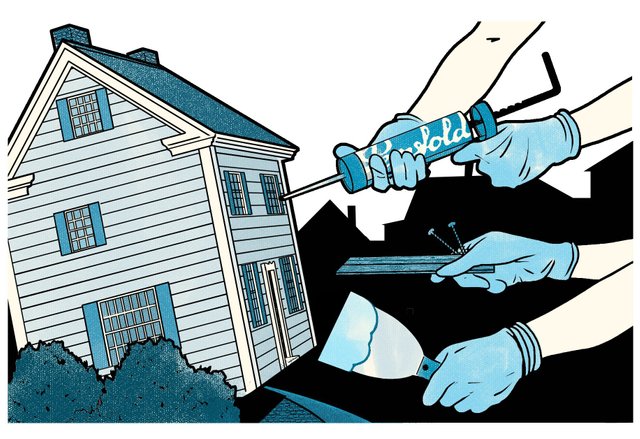Buying an Older Home?

My client very excitedly called me other day super convinced that she FINALLY found the property she would like to call home. I was happy for her (at the same time surprised) that she wanted to buy a property that was built in 1973!
I have been working with her for quite some time and she was always super clear that she would like to go for a property that’s zero maintenance and potentially will NOT demand her attention for couple year, so I have been focusing on all NEW properties. What caused this change of heart? Upon further inquiry, I realized that this is fixer-upper property and all “right” updates have been done, most important, my client just wanted to own this.
Remember we are in competitive market in Eastside and even during this month this property was able to create July/August month’s frenzy! The investor knew his game well and looking at all numbers and kind of foot-traffic this property received it was very clear that house was set for ‘potential’ bidding-war, and my very conservative client was mentally-prepared to waive maximum contingencies (including Inspection).
But luckily, good sense prevailed, and just before signing all paper-work, we got hold of the Inspection report (thanks to the investor for making this available, we truly owe this to you). When we went through the details it was clear that this house is waiting-to-guzzle-several-thousands-dollars-of-on-going-maintenance. All big-ticket items were Red-Flag – electrical cabling, siding, foundation (along with several small issues).
Older homes (30/40++ years) were built following different standards. Some of these standards are banned now (for example, Lead paint, asbestos, aluminum wiring, etc.), however, these banned building materials still remain in most of these older houses. I have come up with few pointers that will help you in making right decision if you are considering purchasing one of these old homes.
Dated building material and technology
You name it – heating, plumbing, insulation, windows, roofing, wiring all are built when home was built (in most of the cases). All these are expensive repairs. Redoing the home with new wiring or plumbing will cost you fortune.Foundation
Cracks, deteriorating mortar, potential water leaks affecting the foundation sure going to directly affect the very structure of the building. Do look out for damp basement, mildew smell as warning signs.Framing
With age, even if the framing is real solid wood (unlike today’s new popular kiln dried/engineered lumber) age and possible termite/beetle infestation are real problems. This sure is big ticket item depending on the extent of damage.Lead Paint
Any home built before 1978 will have Lead Paint (as this was accepted standard). Common justification given – the house has been painted several times and hence lead paint is way beneath the layer. Do pay attention to window castings, door frames etc. for chipping or rubbing paint. Make a known choice if you still have to buy, find out the kind of remediation project and related cost you are signing up for (with this purchase). Read more about health hazards (of lead paint) here.Mold
Specially wet NW weather and age of house is perfect combination for this potential health hazard. Do pay attention, specially so, if house has been vacant for some time. Mold remediation may be expensive affair depending on severity of the problem. Read more about mold related health hazard here.Bat and Rodents
This could be real nuisance if not paid attention early on. Specially bat infestation as these some under endangered species category and you cannot kill or force them out of your house as you please! You are legally allowed to get rid of bats only twice a year and you need professional help to get this done and to get its poop cleaned (as its toxic and professional handling is required). Obviously expensive affair.Moisture
Its serious issue. Pay attention to leaking roof, staining, peeling paint, discolored paint on ceiling (all rooms and specially in the bathroom). Do take any such signs seriously. If you see any such signs ask questions, Look into gutter and any seepage from the gutter space into the structure/foundation. Try to get to the source of the problem, involve professional for second opinion. As this problem could lead to other obvious problem of Mold.Walls and Flooring
Do check if the wall has wall-paper? How many layers? Why? If you wish to change the wall color and if it has layers of wall-paper what it might cost?Wiring and Plumbing
Pay attention if the wiring is knob and tube. Why? The paper insulation around this wiring doesn’t last long exposing wire and potential fire hazard. Do ask questions about wiring age, plumbing related updates?
Back in those days brass with galvanized steel or lead based solder was popular and it will not last forever making your drinking water hazardous; you can do lead detection using lead detection strip. If in doubt make this one of the items to whet out during inspection.Insulation and Heating
Check roof age it directly affects the insulation of a home.
Look out for proper heating and the way heating system has been maintained as poorly maintained heating system could be fire hazard. Reconsider specially if house in question has oil-based heating system!
If house has boiler check its age (more than 20 years?), get chimney checked for soot/sign of aging, check radiators condition to ensure system is working.Windows
Yup! Single pane was the norm then and these are not energy efficient. Do ask if windows are upgraded to double pane? Window upgrades are expensive depending on house size.